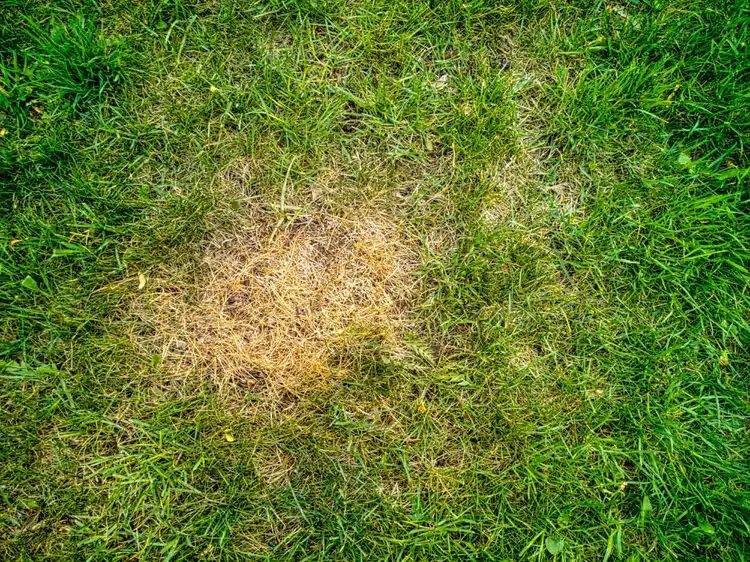A thriving lawn is easy to spot from down the street, thanks to its uniform dark green appearance. Unfortunately, brown spots on a lawn also stick out amid all the green. There are several things that can cause dead patches of turf, such as pests, diseases, and overdoing fertilizer. However, lawns can usually recover with simple care. Use this guide to figure out the cause of brown patches on your lawn and get solutions for fixing the problem.
1. Fertilizer Burn
Brown spots on lawns caused by fertilizer burn are usually at the site of a fertilizer spill or in strips where overlapping fertilizer passes were made. Lawn fertilizer includes salts in addition to valuable nutrients. Salts in high concentrations are deadly to turf. If you spill fertilizer when filling a spreader or make overlapping passes as you spread the product, soil in the affected area can become overloaded with salt, killing nearby grass.
What to do: If you suspect fertilizer burn and can treat the area immediately, remove any visible fertilizer pellets. Then, drench the area with water to move the salts through the soil and away from plant roots.
If the fertilizer has already killed the grass, drench the soil with water to leach out salts. If the area is smaller than your fist, you don’t need to do anything further. Nearby grass plants will fill in the dead spot. Reseed with the same type of grass in larger spots.
2. Herbicides
Misapplied herbicides are a frequent cause of dead patches. Perhaps you were spot-spraying weeds and overshot the weedy invader or misfired and sprayed the grass. Non-selective herbicides, such as glyphosate, kill grass plants within days. It is essential to use herbicides with extreme caution.
What to do: If you catch the problem right away, you can attempt to rinse the turf with a strong and steady stream of water. This is rarely effective, but it can lessen the damage. Reseed large dead patches caused by herbicide. Before reseeding, confirm that the herbicide does not contain a preemergent product. A preemergent prevents grass seed from germinating for a specified period. Reseed after the preemergent dissipates.
3. Dog Spots
If your lawn is frequented by a dog, it is not uncommon for circular brown patches to appear. Dog urine has a high concentration of nitrogen, which can burn turf grass. Dog spots are most prominent in early spring in regions with cold winters where urine is less likely to disperse in the frozen soil.
What to do: If the dead patch is smaller than your fist, do nothing. Nearby grass will fill in the patch. Reseed larger areas after thoroughly drenching the soil to leach away excess nitrogen.
4. Salt Burn
Deicing salt may be effective at combating snow and ice, but it can damage nearby turf if over-applied. When narrow strips or spots of dead grass appear alongside sidewalks and driveways in early spring, deicing salt might be the cause. When the deicing product runs off the pavement, it can concentrate in the soil, burning the lawn.
What to do: Drench the affected area with water to move high salt concentrations through the soil profile. Reseed as soon as possible in spring. Limit deicing salt application as much as possible to prevent salt burn.
5. Debris Under the Surface
The cause of the dead spot might be under the turf. More common on new lawns than established ones, dead spots caused by construction debris or rocks under the soil surface show up during periods of heat or drought. The debris under the surface limits root growth, which makes the plant susceptible to weather stress.
What to do: Remove the debris. Dig up the affected area, removing rocks and construction debris. Backfill with quality topsoil and reseed.
6. Grassy Weeds
When warm-season type of turf grass is invaded by cool-season species and vice versa, seemingly dead patches appear. The brown patches are clumps of the dormant, non-dominate grass. For example, a cool-season Kentucky bluegrass lawn with pockets of rogue zoysiagrass will display what appear to be dead patches in spring and fall. The brown patches are dormant zoysiagrass, which is only green during the warmest part of the year, while Kentucky bluegrass thrives from spring through fall. The same scenario can play out on a warm-season lawn.
What to do: Eradicate the weed grass by hand-pulling or modify management practices to favor the strong growth of the desired grass so it will out-compete the weed grass. Broadleaf herbicides are not effective as the “weed” is a grass plant so you would need to use a weed killer that is effective on grasses.
7. Patch Disease
As its name implies, patch disease produces roughly circular dead areas on a lawn. There are several forms of patch diseases—necrotic ring spot, summer patch, and brown patch are all similar in appearance and management. Caused by diseases that attack plant roots and stems, patch diseases show up when the lawn is stressed. Necrotic ring spot tends to be most active in late spring and fall, while summer patch and brown patch are more common during the heat of summer.
What to do: Begin by getting a conclusive diagnosis. Connect with your local extension service and inquire about turf disease testing. Patch diseases typically show up on lawns plagued by excessive thatch, poor soil conditions, or over- or under-fertilization. Good lawn care practices go a long way toward curing and preventing patch disease.
How to Repair Brown Spots in Lawn
A healthy lawn fills in brown spots naturally once you've remedied the cause. Speed the process along by removing some of the dead grass blades so you can see the soil. Mix a couple of handfuls of grass seed with a scoop of garden soil. Sprinkle the seed and soil mix over the affected area and water lightly. Keep the area moist until the grass seed germinates.




















